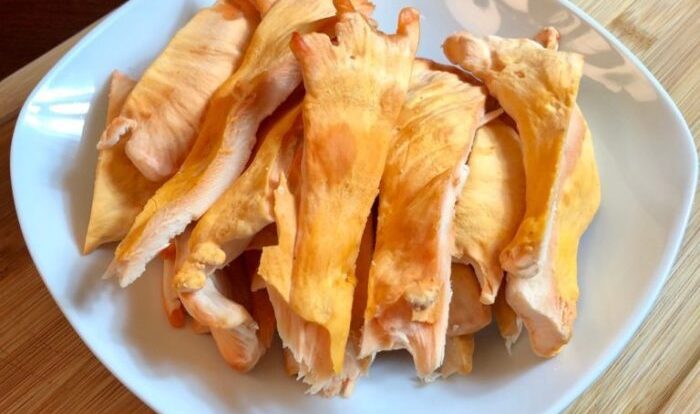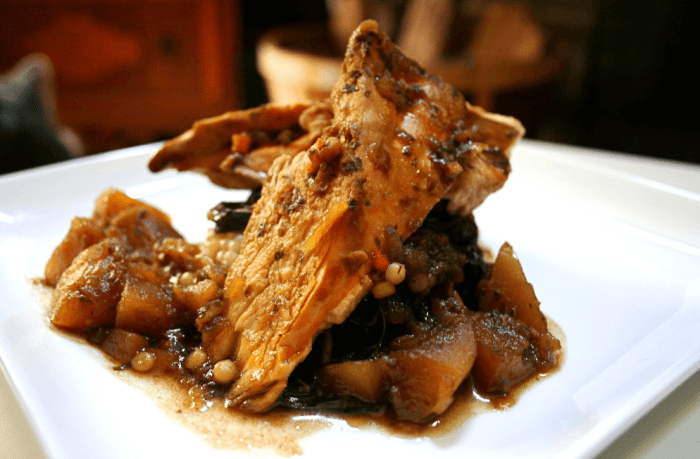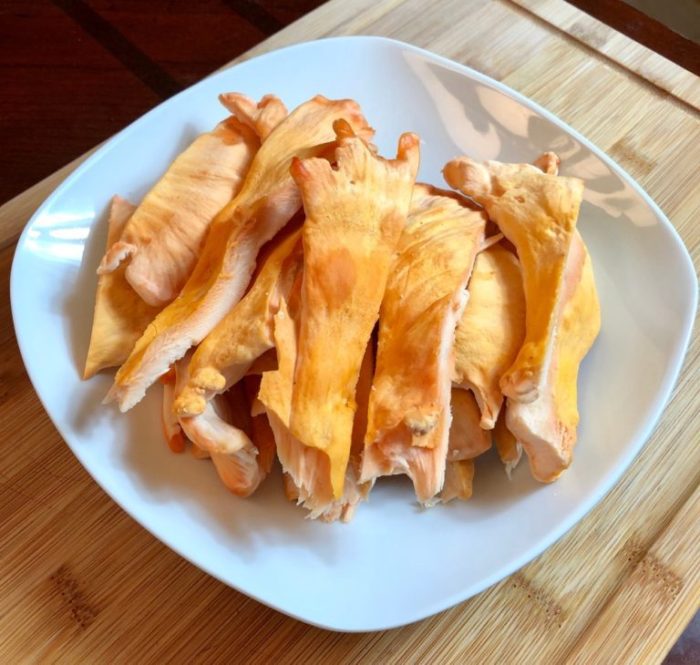
Embark on a culinary adventure with the tantalizing chicken of the woods recipe. This wild mushroom offers a delectable treat, ready to be transformed into a symphony of flavors that will ignite your taste buds. From foraging techniques to cooking methods and health benefits, we’ll explore everything you need to know about this culinary gem.
Chicken of the woods, with its vibrant colors and unique texture, is a versatile ingredient that can elevate any dish. Whether you’re a seasoned chef or a culinary novice, this guide will empower you to create mouthwatering meals that showcase the magic of this woodland treasure.
Culinary Delights
Chicken of the woods is a delicious and versatile mushroom that can be prepared in a variety of ways. Here is a step-by-step guide on how to prepare chicken of the woods for a delectable meal:
Ingredients, Chicken of the woods recipe
The essential ingredients for cooking chicken of the woods are:
- Chicken of the woods mushrooms
- Olive oil
- Salt and pepper
- Optional: other seasonings, such as garlic, thyme, or rosemary
The amount of each ingredient will depend on the number of mushrooms you are cooking.
If you’re craving a unique culinary experience, the chicken of the woods recipe is a must-try. This wild mushroom is a culinary delight, with a texture resembling chicken and a slightly earthy flavor. Its versatility allows for various cooking methods, from sautéing to grilling, making it a perfect addition to your next meal.
Flavorful Varieties

Chicken of the woods’ versatility extends beyond its texture, making it a culinary delight in various forms. Sauces, marinades, and seasonings bring out the mushroom’s natural flavors, transforming it into a centerpiece of both simple and complex dishes.
Simple Preparations
For a quick and easy meal, sauté chicken of the woods in butter or olive oil with a sprinkle of salt and pepper. The mushroom’s meaty texture and subtle flavor shine through with this basic preparation. Alternatively, grill the mushroom slices for a smoky twist, brushing them with a mixture of olive oil and balsamic vinegar.
Complex Delicacies
For a more elaborate dish, braising chicken of the woods in a rich sauce adds depth and complexity. Simmer the mushroom in a mixture of red wine, beef broth, and herbs until tender and flavorful. Alternatively, stuff the mushroom caps with a mixture of breadcrumbs, herbs, and cheese, then bake them until golden brown.
Health Benefits and Nutritional Value

Chicken of the woods is a nutritional powerhouse, boasting an impressive array of health-promoting compounds.
For those seeking a more rustic and savory experience, the chicken of the woods recipe offers a unique twist. This wild mushroom is often found in forests and has a distinct, meaty texture. Whether you prefer to pan-fry it with butter or incorporate it into a flavorful soup, its earthy notes will tantalize your taste buds.
Its low-calorie content makes it a guilt-free addition to your diet, while its high fiber content aids digestion and promotes satiety.
Antioxidants
- Chicken of the woods is brimming with antioxidants, such as ergothioneine and phenolic compounds.
- These antioxidants combat free radicals, reducing oxidative stress and potentially lowering the risk of chronic diseases like cancer and heart disease.
Vitamins and Minerals
- It’s a rich source of vitamins, including vitamin D, B vitamins, and vitamin C, which support immune function, cell growth, and energy metabolism.
- Minerals such as potassium, phosphorus, and iron are also present, contributing to electrolyte balance, bone health, and oxygen transport.
Comparison to Other Mushrooms
Compared to other edible mushrooms, chicken of the woods stands out with its higher protein content and comparable levels of vitamins and minerals.
Its unique flavor and texture make it a versatile culinary choice, adding depth to soups, stews, and stir-fries.
Identification and Foraging Techniques
Chicken of the woods is a distinctive mushroom that can be easily identified in the wild. Its vibrant orange-yellow color and shelf-like shape make it stand out from other mushrooms. Here’s a comprehensive guide to identifying and foraging for chicken of the woods:
Key Characteristics
- Color:Bright orange-yellow to golden
- Shape:Shelf-like or fan-shaped, with multiple lobes
- Size:Can range from a few inches to over a foot in width
- Texture:Soft and meaty, with a slightly fibrous consistency
- Spores:White to cream-colored
Tips for Successful Foraging
Chicken of the woods is typically found growing on the base or fallen logs of oak trees. It’s most common in late summer and fall. When foraging for chicken of the woods, keep the following tips in mind:
- Check the base of oak trees:This is where chicken of the woods is most likely to be found.
- Look for large, shelf-like mushrooms:Chicken of the woods can be quite large, so don’t overlook any big mushrooms you see.
- Examine the color and texture:The vibrant orange-yellow color and soft, meaty texture are key identifying features.
- Avoid mushrooms that are slimy or rotten:These are not safe to eat.
- Harvest only what you need:Leave some mushrooms behind for other foragers and wildlife.
Culinary Inspiration and Creativity: Chicken Of The Woods Recipe

Unlock the culinary wonders of chicken of the woods with a signature recipe card that tantalizes the senses. Design a visually appealing card featuring a mouthwatering photo of your signature dish, complete with a captivating description and step-by-step instructions. Highlight the unique flavors and textures of this versatile mushroom, inspiring home cooks to create their own culinary masterpieces.
Organize a comprehensive recipe table, meticulously listing the ingredients, quantities, and cooking times. This user-friendly format allows for quick and easy reference, ensuring that every culinary adventure is a success. Showcase a diverse range of recipes, from classic sautéed preparations to innovative fusion dishes, empowering home cooks to explore the limitless culinary possibilities of chicken of the woods.
Social Media Campaign
Harness the power of social media to ignite a culinary revolution around chicken of the woods. Create a dedicated hashtag, encouraging food enthusiasts to share their own creations and culinary adventures. Feature stunning food photography, engaging videos, and interactive Q&A sessions with expert chefs.
Inspire a global community of food lovers to embrace the culinary potential of this extraordinary mushroom, transforming their meals into unforgettable gastronomic experiences.
Closing Summary
As you delve into the world of chicken of the woods, you’ll discover a world of culinary possibilities. From simple sautéed preparations to complex sauces and marinades, the versatility of this mushroom knows no bounds. Embrace the flavors of the forest and let chicken of the woods become a staple in your culinary repertoire.
Remember, foraging for wild mushrooms requires knowledge and caution. Always consult with an expert before consuming any wild mushrooms. With the right guidance and a dash of culinary creativity, chicken of the woods will unlock a world of gastronomic delights.
FAQ Explained
Is chicken of the woods safe to eat?
Yes, chicken of the woods is generally safe to eat when properly identified and cooked. However, always consult with an expert before consuming any wild mushrooms.
How do I identify chicken of the woods?
Chicken of the woods typically has a bright orange or yellow color, with a velvety texture and a white, stringy interior. It grows in clusters on trees, especially oak trees.
What are some cooking methods for chicken of the woods?
Chicken of the woods can be sautéed, grilled, roasted, or fried. It can also be added to soups, stews, and sauces.
What are the health benefits of chicken of the woods?
Chicken of the woods is a good source of fiber, protein, and antioxidants. It may also have anti-inflammatory and anti-tumor properties.





